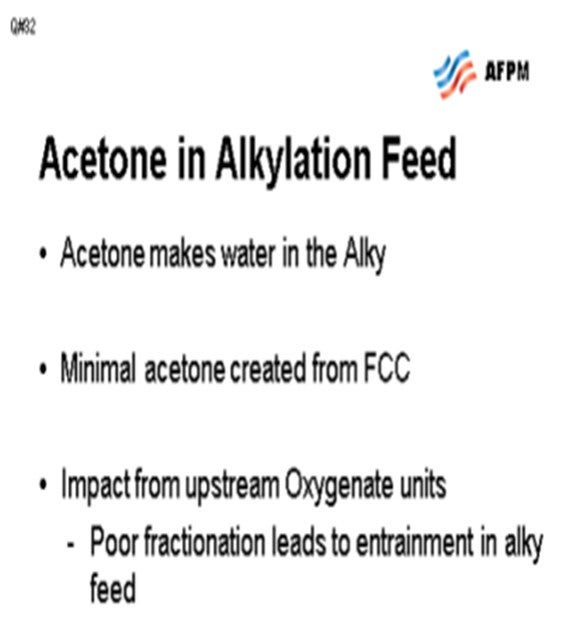Question 32: What are the impacts of the presence of acetone in the alkylation unit feed? How is this formed in the FCC? Comment on both HF and sulfuric units.
STEVES (Norton Engineering Consultants, Inc.)
In both HF and sulfuric acid units, acetone will consume acid, resulting in a reduced acid strength. Regarding sulfuric acid units, some documentation that I got from DuPont STRATCO indicated that one pound of acetone will consume about 10.5 pounds of acid. When talking with some HF alkylation experts, I was told that one pound of acetone in an HF unit will consume about half a pound of acid.
Acetone formation in FCC is suspected to be caused by oxygen carry under from the regenerator into the reactor section. I do not have a lot more detail on that. I would suggest that maybe you ask the FCC panel and see if you can stump them.
Typical acetone concentrations in the alkylation unit feed are about 100 ppm (parts per million) to 200 ppm. In HF alkylation units, levels above 250 ppm can lead to significant production of light ASO (acid-soluble oils), and the acid can become deep red as the acid strength falls.
MUEHLBAUER (Valero Energy Corporation – Benicia Refinery)
Similar to Chris, my experience is that acetone in the alkylation unit feed makes water; so, it requires more acid regeneration for the HF units and higher acid makeup rates for sulfuric units. Within Valero, we do not see acetone as a primary contaminant for our alkylation units. There is only one of our refineries that we actually test for acetone. Most of the oxygenates we found from the FCC were actually phenolic, so they would boil more in the gasoline range rather than end up in the alkylation unit feed.
I want to make one comment. In refineries that have configuration with an upstream oxygenate unit like MTBE/TAME (methyl tertiary butyl ether)/ (tertiary amyl methyl ether) or an isooctene unit, if there is poor fractionation in those units, you could get carryover of alcohol derivatives, such as acetone and dimethyl ether, which would impact alkylation feed. It is obviously becoming much less common in the U.S.; but for international facilities, it may still apply.

DAVID SMITH (UOP, A Honeywell Company)
A potential solution for removing the acetone from the alkylation unit feed is to use the hybrid adsorbent AZ-300. This adsorbent removes a wide variety of oxygenates, including acetone, as well as the water from the alkylation feed.
KURT DETRICK (UOP, A Honeywell Company)
Actually, the acetone can make water in an HF alkylation unit, but not all of it does. In fact, 100 ppm to 200 ppm acetone in the feed to an alkylation unit is not unusual, although it is usually a little less. If that much water actually came into the alkylation unit, you would know it. It would be pretty bad. So, we believe that some of the acetone probably makes water, but not nearly all of it. The majority of it probably works its way out the bottom of the regenerator in most units. At the typical levels that were listed, I think that most units are able to push it out the bottom of the regenerator over time. It does build up in the acid a bit. We have actually done sampling and found acetone in the circulating acid, so it is somewhat stable. One possible cause of high levels of acetone in the FCC unit LPG (liquefied petroleum gas) is insufficient deaeration of the steam used in the FCC stripping section. This allows oxygen to get into the reactor and provides the possibility of making acetone.
RANDY PETERSON (STRATCO® - DuPont)
We have analyzed olefin feed samples from a refiner that complained of higher-than-expected acid consumption in a sulfuric acid alkylation unit. During this analysis, we were surprised to find high levels of acetone ranging between 700 wppm (weight parts per million) and 1200 wppm in the butylene feed from an FCC.
Acetone consumes acid at a rate of 10.6 pounds of acid per pound of acetone [99.2 wt% (weight percent) to 90.0 wt% acid spending range]. Besides consuming significant acid, this contaminant increases the water content (relative to red oils) in the acid, which causes higher corrosion rates within the alkylation unit.
We are not experts on FCC operation, but we have been told that excess instrument air to the FCC reactor may contribute to high acetone levels in the alkylation unit feed.